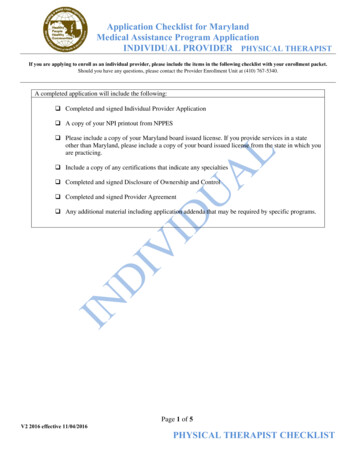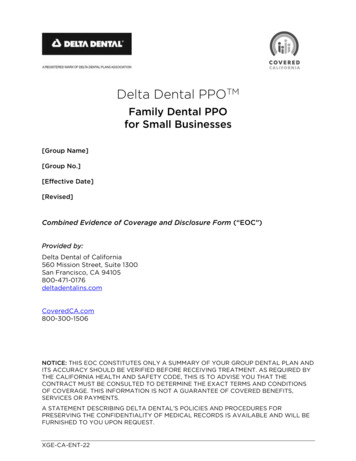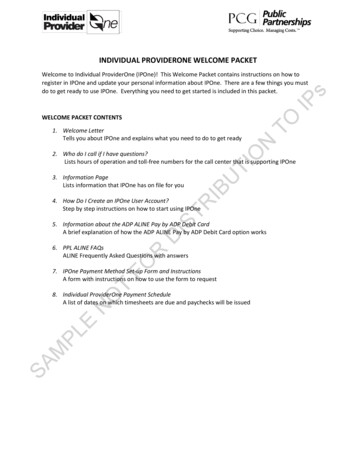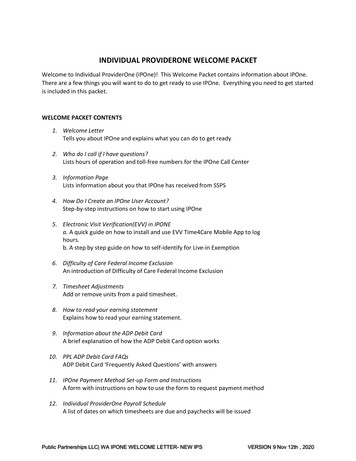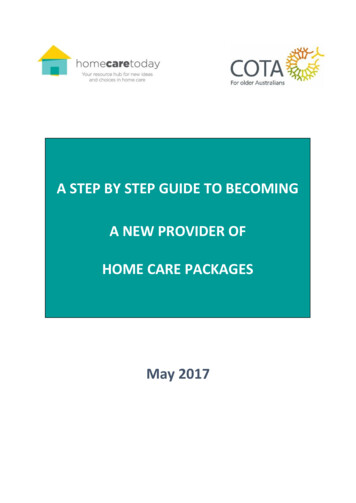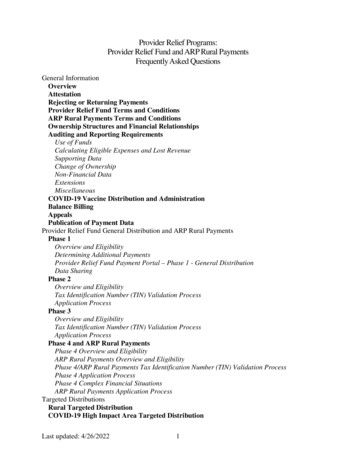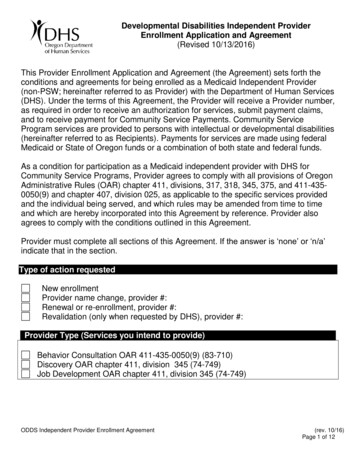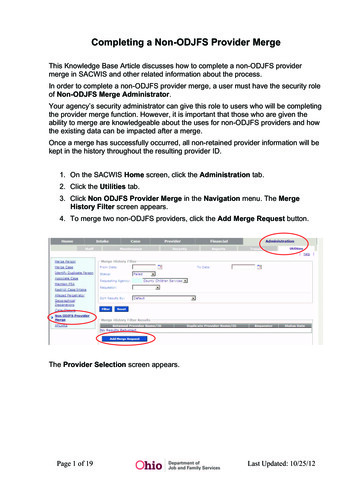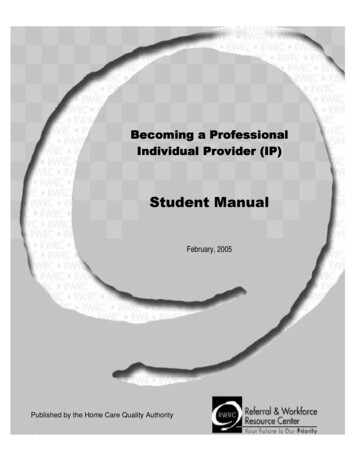
Transcription
Becoming a ProfessionalIndividual Provider (IP)Student ManualFebruary, 2005Published by the Home Care Quality Authority
AcknowledgementsTraining to prepare new workers for in-home care is the result of many peopleacross Washington who share a common vision to improve the individual providerworkforce. The input and expertise we have received comes from all corners ofthe state: from workers, employers and their families, educators, policy-makers,and concerned citizens. Without the extensive network of people who willinglyshared their thoughts, hopes and dreams, this manual and a host of other materialswe’ve developed would not be possible.The work of HCQA is supported through a grant from the Centers for Medicareand Medicaid Services, Department of Health and Human Services to Improve theDirect Services Community Workforce. Grant funds have been used to implementa Referral Registry, and to develop and deliver support programs for individualproviders in four Referral and Workforce Resource Center sites.Home Care Quality Authority:640 Woodland Square Loop SEOlympia, WA 98504Phone: 1-866-HCQA (4 2 7 2)Email: info@hcqa.wa.govWebsite: www.hcqa.wa.gov
About the TrainingThis Becoming a Professional Individual Provider course is three hours oftraining, which is designed to be completed in one continuous session.Key WordsEach section of this course will begin with“Key Words” in which words that are usedin the section will be defined or described.For example, in this section the wordindividual is defined as “How this trainingrefers to individuals receiving publiclyfunded in-home services. It will remind youto treat each person you support as anindividual with unique interests, abilities,preferences, and needs.”You may use the words “consumers” or“employers” or some other word whenreferring to people you support, but it wouldbe beneficial to find out from your employerwhich term(s) they prefer. However,throughout this training, individualsreceiving in-home services will be referredto as “individuals” or, in some instances,“people” or “person.”HomeworkThere will be no written homework in thiscourse.QuizzesAt the end of each section of this course,you will have a short quiz. The quizquestions will be multiple choice. We willgo over the answers together in class.Student ParticipationIt is important to actively participate in allcourse activities. You will be building uponyour knowledge through reflection (yourown experiences, thoughts and perceptions)as well as learning from your colleaguesthrough paired activities or small groupexercises.Word of CautionBefore we start this training, it is important tonote that this training does not replace theprofessional advice of doctors, lawyers, andother experts. This training is based uponwhat are widely considered to be preferredpractices. However, circumstances for eachindividual are unique and therefore requireservices and supports specifically designed tomeet that individual’s needs.As preferences differ from person to person, itis expected that you will familiarize yourselfwith the preferences of your employer. It ispossible that some practices with youremployer will differ from preferred practicesthat you learn from this training. What shouldyou do? Start by talking to your employerabout these differences and the best course ofaction. And remember: never risk your safetyor that of an individual, to do something forwhich you feel unqualified. It is always okay toask for help.
The Individual ProviderOUTCOMESKEYWORDSWhen you finish this session, you will beable to:Define the term “developmentaldisability.”Define the term “functionaldisability.”Identify differences betweenfunctional and developmentaldisabilities.Identify the values of theWashington service system forindividuals receiving in-home care.Demonstrate awareness of your ownattitudes and beliefs about others andhow those attitudes and beliefs mayimpact your work.Describe your general role in theWashington service system forindividuals receiving in-home andself-directed care.Define “philosophy of independentliving;” how it impacts your work.Identify ways to use ethics,observation, communication,decision making, and documentationin your work.Describe your role as a teammember.Use “People First” language.Identify ways to determine howothers would like to be treated.Developmental Disability: Adevelopmental disability begins beforesomeone reaches 18 years of age; issomething that goes on throughout aperson’s life; is a substantial disabilityfor the individual; and often means thereis a need for some kind of assistance.Functional Disability: Pain, weakness,stiffness or paralysis caused by sprain,stroke, traumatic brain injury, or due tocongenital (a condition a person is bornwith) disability.Individual Provider (IP): An IP workswith and supports people withdevelopmental disabilities, who areelderly and others who receive publiclyfunded services where they live andwork.Individual: How this training refers toIndividuals you will work for. It willremind you to treat each person yousupport as an individual with uniqueinterests, abilities, preferences, andneeds.People First Language: Language thatrefers to the qualities of a person, not aperson’s disabilities.Platinum Rule: Treat others as theywould like to be treated.Professional Ethics: A set of standardsto guide one’s professional behavior.Values: Ideals that shape the quality ofservices and supports.
Introductionhat is the reason for thisIndividual Provider (IP)training? There are tworeasons, and they areconnected to each other.The first is to help you do the best jobyou can in supporting individuals tohave a better quality of life. The secondreason is this: when you do the best jobyou are able to do, your professional lifeWshould be more rewarding, which shouldimprove your quality of life. As an IPthere is something valuable in thistraining, not only for the individuals youare working with, but for yourselfpersonally. There is nothing better than asituation in which everyone wins! Wewill begin the training by getting toknow each other and learning moreabout what the training will cover.ACTIVITYGetting to Know YouDirections: Pair up with someone in class. Take turns asking each other the following questions.Write your partner’s answers below.What is your name?Where do you work (or where have you worked recently)?What are three positive words that describe how you feel about the work you will do as anindividual provider?123Becoming a Professional Individual Provider – Session One: The Individual Provider5
Supporting a Better Quality of LifeSo what does “quality of life” mean? Itmeans different things to differentpeople. Generally, people experience agood quality of life when they:Are able to make choices intheir lives, and their choices areencouraged, supported, andrespected.Have close, supportiverelationships with friends andfamily.Live in a home that iscomfortable for them and withpeople who know and careabout them.Participate in activities they findenjoyable.Have access to health care andhave the best possible health.Feel safe and are safe.Are treated with dignity andrespect.Are generally satisfied withtheir lives.ACTIVITYDirections: Think about what “quality of life” means for you. Write down five things that areimportant in your life (things you think are necessary for you to have a good quality of life).1.2.3.4.5.6Becoming a Professional Individual Provider – Session One: The Individual Provider
Supporting a Better Quality of Life, continuedNow let’s see what some people with developmental disabilities have to say about whatquality of life means to them. In 2003, a number of individuals with developmentaldisabilities were asked, “What does quality of life mean to you? What things areimportant in your life (things that you think are necessary for you to have good quality oflife)?” This is what they said:SOURCE: Community Conversations with People with Developmental Disabilities in California.Published by California Department of Developmental Services athttp://www.dds.cahwnet.gov/cac/pdf/CAC ConversationswDD.pdfBecoming a Professional Individual Provider – Session One: The Individual Provider7
Supporting a Better Quality of Life, continuedIn many of the above areas, the individuals surveyed felt they were doing pretty well;however, individuals said they specifically wanted more choices in the area ofrelationships, personal care, and personal freedom.RelationshipsIn the area of relationships, they wanted to spend more time with friends, see theirfamilies more often and at holidays, spend some time with boyfriends and girlfriends, andget married.Personal CareIn the area of personal care they wanted better trained doctors and more of them, goodhealthy food available, and more recreational opportunities.Personal FreedomIn the area of personal freedom, they wanted to spend more time in the community, tomake their own decisions about when to go on a diet, to go on more vacations, and to bemore a part of their communities.People wanted to say some very specific things to the people who support them: thatmeans you. They want to wear clean clothes; to decide on their own bedtime and not tohave a schedule; to watch the television programs they like at the times they want; to seeboyfriends and girlfriends when they want; and, to invite more visitors to come over tovisit.1As we go through this training, listen, learn, and think about what individuals you will orcurrently support have to say about what is important to them and how you can applywhat you learn in supporting the individuals you serve to lead quality lives.1Excerpted and Adapted from Department of Developmental Service’s Consumer AdvisoryCommittee, Community Conversations with People with Developmental Disabilities inCalifornia.8Becoming a Professional Individual Provider – Session One: The Individual Provider
The Individual ProviderAN Individual Provider (IP) works with and supports individuals in theplaces they live and work. IPs perform their jobs in privately-ownedhomes, licensed homes, day programs, supported or independent livingenvironments, or work sites. An IP has many important roles to play.You are:A PARTNER, supporting individuals in leading independent lives andparticipating in and contributing to the community.A TEACHER, finding creative and fun ways to help individuals learnmeaningful skills and providing them with information to make the best choicesfor themselves.An AMBASSADOR to the individual’s community, encouraging others tosupport individuals you support as neighbors, friends, and co-workers.An ADVOCATE, supporting individuals in exercising their rights andresponsibilities.A SUPPORTER seeking to understand the likes, dislikes, hopes, and dreams ofindividuals you support and cheering individuals on as they make progresstoward their life goals.All of the roles that you play have a common focus on supporting individuals to live thekind of life they hope and dream about. The IP is a Partner, Teacher, Ambassador,Advocate, and Supporter.The IP is not a boss or one who orders people around and makes them do things they mayor may not want to do. Likewise, the IP should not act like a parent to the people theysupport who are not their own child.The job of the IP carries a great deal of responsibility, and it is easy to get these rolesconfused. Unlike a parent, legal guardian, or conservator, the IP who is not related to theperson they support does not have the responsibility to make important life decisions forindividuals they work for and with.Instead, the individuals themselves, with the help of parents, legal guardians, families, orconservators, as appropriate, make decisions about their own lives.Becoming a Professional Individual Provider – Session One: The Individual Provider9
Scenario: Role of the Individual ProviderFeaturingJarredA 23 year-old manMikeJarred’s individualproviderLoisHealth club managerJarred is sitting on the front steps of his house. He looks dejected. Mike, his individualprovider, asks Jason why he looks bummed out.Jarred:“I got kicked out of the gym.”Mike:“Why?”Jarred:“Some guys were calling me names.”Mike:“Why did they do that?”Jarred:“I don’t know.”Mike:“Which gym were you playing at? The one on Main Street?”Jarred nod his head yes.Mike:“I know that gym. I’m gonna call them and find out what’s wrong.”Mike is inside the house on the phone. He calls Lois, the health club manager.Mike describes Jarred to Lois.Lois:“Oh yeah, that slow guy.”Mike:“Well, ah, I was wondering why he was asked to leave the gym the other day.He says he was kicked out.”Lois:“He doesn’t know how to play basketball properly so he gets fouled all thetime. I figured I saved him from getting beat up.”Mike:“Maybe his basketball and social skills aren’t the best, but Jarred really enjoysplaying basketball. Is it okay for him to still come to the gym?”Lois:“Maybe it’s just better if he plays at the park.”10 Becoming a Professional Individual Provider – Session One: The Individual Provider
Mike:“Well, we do go to the park and he enjoys that. But the gym is much better forhim.”Lois:“Okay, okay. I get it. Don’t make problems for me. Since he’s special, I’llmake a deal with you. I’ll keep the gym open an extra hour just for him whileI do paperwork.”Mike:“That’s nice, but Jarred really needs to learn social skills and team work. If Icome with him, can he continue to come to the gym?”Lois:“Okay if you can teach him social skills, I suppose that’s okay.”Later, Mike and Jarred are playing basketball in the driveway of Jarred’s house.Mike:“Hey, I talked to the lady at the gym and she said you can still come to thegym, but I gotta teach you a little about basketball first. What was that namethose guys were calling you?”Jarred:“Fouler-baby.”Mike:“Let me show you something. Why don’t you try to defend me?”Mike dribbles the ball as Jarred nudges really close, blocking Mike’s every move.Mike:“Whoa! You can’t get that close to people, or else it’s a foul. Let me showyou how to do it.” (Mike shows the proper way to block a shot.) “See howI’m not touching you? Why don’t you try it.”Jarred blocks Mike’s shot successfully—just the way Mike showed him.Mike:“Good defense! Good job, Jarred!”Weeks later, Mike and Jarred are inside Lois’ office at the health club.Mike:“We’ve been coming to the gym for about two weeks now and Jarred’s havinga really good time. We wanted to see how he’s doing.”Lois:“Okay, I guess. Lucky for you so far.”Mike:“Like I said, Jarred has really enjoyed himself and we were hoping he couldjoin your league team.”1. What roles do Mike play?2. How is Mike an Advocate?3. Does Jarred’s quality of life change as a result of Mike playing the different roles?Becoming a Professional Individual Provider – Session One: The Individual Provider11
ACTIVITYIndividual Provider Roles and ResponsibilitiesDirections: Read the following scenario. Draw a line from each activity to its matching role.Some roles will have more than one activity attached to them.Mary, a new IP, asked Tom, a fellow IP, to tell her what he does during a typical work day. Here aresome of the activities Tom did:ROLESPartnerTom talked to Martha, the case manager, about gettingready for A.J.’s planning meeting scheduled for Tuesday.Tom would like to see A.J. get a bus pass for theTacoma area now that he uses the bus to go to work.Tom assisted A.J. with his medication.TeacherTom spent time teaching A.J. how to put a tape into hisown VCR.Tom helped A.J. and Marissa make breakfast.AmbassadorTom talked with Marissa about her parents. Marissafeels that her parents are too controlling.Tom helped A.J. clean up his room.AdvocateTom talked to Martha about tacking down a piece ofcarpet that A.J. tripped over.Tom helped A.J. pick out matching clothes to wear.SupporterTom talked to A.J.’s boss at Starbucks. He answeredhis questions about A.J.’s disability.A.J.’s counselor was late for an appointment, andTom could tell that A.J. was upset. Tom went for a shortwalk with A.J. to help him settle down.Tom helped Marissa make a list of questions for thedoctor before he took her to her appointment.12 Becoming a Professional Individual Provider – Session One: The Individual Provider
Teaming with Others to Support IndividualsAnother important role that the IP playsis that of a Team Member. As an IP, youare a member of several teams: the teamof staff who work to support individualsin the home, each person’s individualsupport team, and each individual’s careteam. People who might be part of theseteams include: individuals and theirfamilies; the case manager and other IPs,both in the home and at a dayor work site; health care professionals,and other representatives fromcommunity agencies.You will find that working as part of ateam is often better than working alone.Sharing information and ideas with teammembers leads to creative planning andproblem solving. In order to protectyour employer’s privacy, only shareinformation with people named on theIndividual Service Plan.The Individual Provider ProfessionPeople like you, who support individualsin their daily lives, were not alwaysconsidered “professionals.” Morerecently, the importance of thechallenging work that you and other IPsperform has gained broad recognitionand acknowledgement as a profession.Specific knowledge, skills, andcommonly agreed-upon standards forprofessional conduct are what separate a“job” from a “profession.” This trainingfocuses on the skills, knowledge, andabilities that have been identified byindividuals receiving Medicaid services,individual providers, and others ascritical to satisfactory job performance.Nationwide, IPs have joined together toform a professional organization calledthe National Alliance for Direct SupportProfessionals (NADSP). The NADSPhas developed a set of professionalethics (standards for professionalconduct) for IPs. The complete text ofthe NADSP Code of Ethics is inAppendix A.Information about how to get connectedwith this organization is included in theResources section of this manual.NADSP has a Web site and newsletterwritten by and for IPs that contains veryhelpful and supportive information forIPs.Becoming a Professional Individual Provider – Session One: The Individual Provider13
Values to Guide Your WorkA guiding principle of long-term in-home care in Washington state is that servicesenable people to remain in their own home and community, whenever possible.The overall mission of Washington state’s long-term in-home care system:helps individuals and their families develop and maintain self-sufficiency;remain valued and contributing members of their community; andmaximizes quality of life by managing services that are high quality, costeffective, and responsive to individual needs and preferences.The long-term in-home care system in Washington is also guided by the followingvalues:Individual worth, dignity, respect, self-direction and self-sufficiency.Freedom from abuse, neglect, abandonment, financial exploitation, anddiscrimination.Washington’s long-term in-home care system also promotes quality, safety, access,accountability, and non-discrimination in its service system.SOURCE: Adapted from Department of Social and Health Services Aging and AdultServices Strategic Plan 2006-2011.Individual providers have very important job responsibilities that significantly affect theiremployer’s life. Maintaining dignity and respect while also supporting an individual tomaintain self-sufficiency requires special skills. You can do this by:Making sure that how your employer wants things done is incorporated intohow you perform his/her personal care.Doing everything possible to ensure your employer’s dignity and privacy arerespected.Working with your employer to encourage them to do as much as possible ontheir own.Knowing, taking pride in, and performing your role as a member of the careteam. This includes:- Monitoring changes in your employers health (physical and mental)condition- Knowing when and what to report to the appropriate care teammember(s)Identifying problem situations and taking the necessary action to support youremployer’s well-being.Responding to emergencies without supervision if necessary.SOURCE: Adapted from Department of Social and Health Services, Home and CommunityServices, Revised Fundamentals of Caregiving Learner’s Guide, 2003.14 Becoming a Professional Individual Provider – Session One: The Individual Provider
The Individual Provider ToolboxWhether you are working independently or with a team, you will need a setof “tools”—basic skills and knowledge—to help you successfully meet thedaily challenges of your job. Just as a carpenter cannot do a job without ahammer and nails, an IP cannot provide the best possible support toindividuals without the IP tools. Tools in the IP Toolbox are:Ethics: enable the IP to makeethical decisionsObservation: enables the IPto observe people and placesfor things that could affect anindividual’s health and wellbeingCommunication: enables theIP to communicate in avariety of waysDecision making: enables theIP to choose the best course ofaction with the information athandDocumentation: enables theIP to document importantinformation about individualsand eventsMany situations in your work call forusing several tools at the same time.For example, if an individual is sick,you might use every tool in theIndividual Provider Toolbox:Ethics to guide you in promoting theindividual’s physical well-being byhelping to identify the illness andensuring timely medical treatmentwith dignity and respect.Observation by using your senses toidentify changes that are likely to besigns and symptoms of illness. Youmight see the individual rubbing herstomach, feel her skin is cold andclammy, or hear her moaning andsaying “my stomach hurts.”Communication to ask questionsabout someone’s pain such as, “Howlong has it hurt you?”Communication also means listeningand understanding an individual’sresponse.Decision making to decide how torespond to the individual’s illnessbased on what you have observedand what has been communicated.For example, “Do I need to call thecase manager, family or doctor, ortake her directly to the emergencyroom?”Documentation to recordinformation about the illness to bringto the doctor’s appointment.Becoming a Professional Individual Provider – Session One: The Individual Provider15
Scenario: The Individual Provider (IP) ToolboxFeaturingHowardA 72 year-old manSteveHoward’s individualproviderDr. SmithHoward’s doctorHoward is sitting on the examining table in Dr. Smith’s office. Steve, Howard’s IP, issitting off to the side as Dr. Smith talks with Howard, who has not been feeling well.Doctor:“So, Howard, you’ve been sick for ten days and you’re not getting better andnow you have a headache. You probably have an acute sinus infection inaddition to your bronchitis. This will prolong your illness. I think goodmedication will make you feel better. Are you currently taking anymedications?”Howard, unsure, looks to Steve for an answer.Steve:“He takes medication for his heart.”Doctor:“That shouldn’t be a problem. Are you allergic to penicillin or othermedication?”Howard looks again to Steve for an answer.Steve:“Right now he doesn’t have any allergies that we know of.”Doctor:“I’m going to prescribe you Amoxicillin, which will help fight your sinusinfection. I want you to take one pill a day for ten days. Keep taking it even ifyou feel better. The other thing I’m going to prescribe is a cough medicine.Take one teaspoon every six hours as needed for your cough. Anyquestions?”Steve:“Are there any side effects or anything? Anything else you can think of,Howard?(continued)16 Becoming a Professional Individual Provider – Session One: The Individual Provider
Doctor:“Well, an allergic reaction is a side effect of Amoxicillin, but since he hasn’thad an allergic reaction before, he probably won’t have one this time. But, ifhe gets short of breath, develops a rash or hives, stop taking the medicine andcall us immediately. When you pick up your medication at the pharmacy, thepharmacist will give you a medication sheet with detailed information. If youhave any questions about the medicine, go ahead and ask the pharmacist.”Steve:“Sounds good. That’s all I can think of. Howard, is there anything you wantto tell the doctor while we’re here?”Howard: “No.”1. How did the IP use Ethics?2. How did the IP use Communication?3. How did Howard feel?Becoming a Professional Individual Provider – Session One: The Individual Provider17
The Individual Provider Toolbox: Additional InformationETHICSEthics are rules about howpeople think they and othersshould behave. People’s ethicsare influenced by a variety offactors, including culture,education and the law.The NADSP developed a Code ofEthics (Appendix A) to guide thebehavior of IPs. Refer to the Code whenin doubt about the most ethical thing todo.Here is a condensed version of theNADSP Code of Ethics:1. Advocacy: As an IP, I will workwith the individuals I support to fight forfairness and full participation in theircommunities.2. Person-Centered Supports: Asan IP, my first loyalty is to the individualI support. Everything I do in my job willreflect this loyalty.3. Promoting Physical andEmotional Well-Being: As an IP, Iam responsible for supporting theemotional, physical, and personal wellbeing of individuals receiving supportwhile being attentive and energetic inreducing their risk of harm.4. Integrity and Responsibility: Asan IP, I will support the mission of myprofession to assist individuals to livethe kind of life they choose. I will be apartner to the individuals I support.5. Confidentiality: As an IP, I willprotect and respect the confidentialityand privacy of the individuals I support.6. Fairness: As an IP, I will promoteand practice fairness for the individuals Isupport. I will promote the rights andresponsibilities of the individuals Isupport.7. Respect: As an IP, I will respect theindividuals I support and help othersrecognize their value.8. Relationships: As an IP, I willassist the individuals I support todevelop and maintain relationships.9. Self-Determination: As an IP, Iwill assist the individuals I support todirect the course of their own lives.OBSERVATIONObservation is noticing changein an individual’s health, attitude,appearance, or behavior.Get to know the individual so you cantell when something changes.Use your senses of sight, hearing,touch, and smell to observe signs orchanges.Get to know the individual’senvironment and look for things thatmay impact an individual’s and other’ssafety and well being.COMMUNICATIONCommunication isunderstanding and beingunderstood.Listen carefully to what is beingcommunicated through words andbehavior.Repeat back what was communicatedto confirm understanding.Ask questions to gain a more completeunderstanding.Be respectful.18 Becoming a Professional Individual Provider – Session One: The Individual Provider
The Individual Provider Toolbox: Additional InformationDECISION MAKINGDecision making is choosingthe best response to a situationwith the information that isavailable to you. Decisionmaking is an ongoing process.Recognize/define the situationIdentify possible responses andconsider the consequences.Choose a response and take action.Evaluate how your response worked.Were the consequences positive? Ifnot, what could have made it workbetter?Use what you learned to makedecisions in the future.DOCUMENTATIONDocumentation is a writtenrecord.The IP should keepconsumer/employer notes for thefollowing important, non-routineevents in an individual’s life: medicaland dental visits, illness/injury, specialincidents, community outings,overnight visits away from the home,and communications with theindividual’s physician. (Note anychanges in behavior or appearance).Do not document personal opinions,just the facts (for example, who, what,when, and where).Be specific when describing behaviors.Record what the person actually saidor describe non-verbal attempts tocommunicate.Describe the event from beginning toend.Be brief.Becoming a Professional Individual Provider – Session One: The Individual Provider19
Individuals with Functional and Developmental DisabilitiesWho are the people you support? First,they are individuals. The people yousupport are children and adults, male andfemale, and come from interestingbackgrounds just like you. They havemany unique preferences and qualitiesthat you will get to know as you get toknow them. What the individuals yousupport have in common is that theyhave functional or developmentaldisabilities.Functional disabilities are caused by anumber of things: illness, stroke, braininjury, or as a result of congenitaldisability. Symptoms of functionaldisability include pain, weakness,stiffness or paralysis. Persons withfunctional disability require assistancewith one or more daily activities becausethey have varying levels of selfsufficiency or mobility.Additionally, you may also supportchildren who have high physical orpersonal care needs. Other potentialemployers are older individuals whoreceive in-home services that allow themto remain in their own communities.Working with these individuals maypresent challenges, but the rewards faroutweigh those challenges.An IP working with aging adults maywant to consider specialized training orself-study to adequately support personswith cognitive or behavioral al illnessPersonality disordersYou may also work for a person who hasan age-related illness, such asParkinson’s or Alzheimer’s disease.Following is some basic informationabout the causes and kinds ofdevelopmental disabilities. You are notexpected to know everything aboutevery type of developmental disability.However, it is important that you knowand understand the types of disabilitiesthat the individuals you work with havein order to provide them with the best
Individual Provider (IP) Student Manual February, 2005 . across Washington who share a common vision to improve the individual provider workforce. The input and expertise we have received comes from all corners of the state: from workers, employers and their families, educators, policy-makers, . which is designed to be completed in one .
